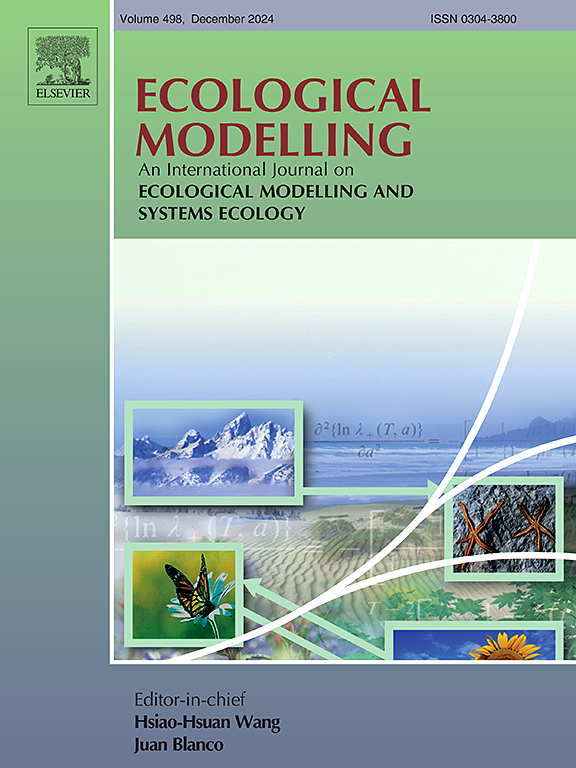Research on the uncertainty analysis of the carbon peak and pivotal influencing factors for provincial agriculture in China
IF 3.2
3区 环境科学与生态学
Q2 ECOLOGY
引用次数: 0
Abstract
A scientific assessment of provincial agricultural carbon emissions (ACE) trends is an essential component for achieving China's "dual carbon" goals. This study aims to investigate the coordinated relationship between agricultural carbon emissions and economic growth, thereby laying a foundation for China's green socio-economic transformation. First, by employing spatial autocorrelation and the Environmental Kuznets Curve (EKC) theory, we identify the spatial patterns of ACE and classify the development stages of the provinces. Second, by integrating the Tapio decoupling model with Markov chains, we reveal the dynamic evolutionary paths and stability of the agricultural "carbon economy" decoupling status. Finally, the Logarithmic Mean Divisia Index (LMDI) decomposition is utilized to quantitatively identify the key driving factors affecting the decoupling process. The results show that China's provincial ACE exhibit significant and persistent spatial agglomeration characteristics. The provinces can be classified into six distinct development stages, with Group AP IV having entered a potential carbon peaking period, whereas some major agricultural production areas still face formidable emission reduction challenges. Provinces widely face a high-probability risk of reverting from a state of strong decoupling to an unfavorable one. Even for provinces with peaking potential, the probability of maintaining strong decoupling is merely 67.6 %, while for major agricultural production areas, the probability of status deterioration is as high as 71.7 %, suggesting that China's agricultural low-carbon transition predominantly follows an extensive dynamic path. Energy Utilization Efficiency (EUE) is the most critical driving force in promoting agricultural carbon decoupling, and across all regional groups, the enhancement of EUE plays a dominant role in emission reduction. This study extends the theoretical understanding of the dynamics of agricultural 'carbon-economy' decoupling, provides a scientific basis for the formulation of regionally differentiated agricultural low-carbon policies.

中国省际农业碳峰值及其关键影响因素的不确定性分析
科学评估省级农业碳排放趋势是实现中国“双碳”目标的重要组成部分。本研究旨在探讨农业碳排放与经济增长的协调关系,从而为中国的绿色社会经济转型奠定基础。首先,运用空间自相关理论和环境库兹涅茨曲线(EKC)理论,分析了我国ACE的空间格局,并对各省的发展阶段进行了划分。其次,通过将Tapio解耦模型与马尔可夫链相结合,揭示了农业“碳经济”解耦状态的动态演化路径和稳定性。最后,利用对数平均分度指数(LMDI)分解定量识别影响解耦过程的关键驱动因素。结果表明:中国省际ACE呈现显著且持续的空间集聚特征。这些省份可以分为六个不同的发展阶段,第四组已经进入了潜在的碳峰值期,而一些主要的农业产区仍然面临着艰巨的减排挑战。各省普遍面临着从强脱钩状态回到不利脱钩状态的大概率风险。即使在具有调峰潜力的省份,保持强脱钩的概率也仅为67.6%,而在农业主产区,状态恶化的概率高达71.7%,表明中国农业低碳转型主要走的是一条粗放型动态路径。能源利用效率(EUE)是促进农业碳脱钩最关键的驱动力,在所有区域集团中,能源利用效率的提高对减排都起着主导作用。本研究拓展了对农业“碳经济”脱钩动态的理论认识,为区域差别化农业低碳政策的制定提供了科学依据。
本文章由计算机程序翻译,如有差异,请以英文原文为准。
求助全文
约1分钟内获得全文
求助全文
来源期刊

Ecological Modelling
环境科学-生态学
CiteScore
5.60
自引率
6.50%
发文量
259
审稿时长
69 days
期刊介绍:
The journal is concerned with the use of mathematical models and systems analysis for the description of ecological processes and for the sustainable management of resources. Human activity and well-being are dependent on and integrated with the functioning of ecosystems and the services they provide. We aim to understand these basic ecosystem functions using mathematical and conceptual modelling, systems analysis, thermodynamics, computer simulations, and ecological theory. This leads to a preference for process-based models embedded in theory with explicit causative agents as opposed to strictly statistical or correlative descriptions. These modelling methods can be applied to a wide spectrum of issues ranging from basic ecology to human ecology to socio-ecological systems. The journal welcomes research articles, short communications, review articles, letters to the editor, book reviews, and other communications. The journal also supports the activities of the [International Society of Ecological Modelling (ISEM)](http://www.isemna.org/).
 求助内容:
求助内容: 应助结果提醒方式:
应助结果提醒方式:


